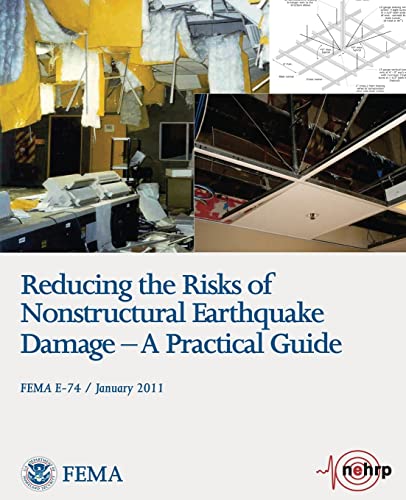Items related to Reducing the Risks of Nonstructural Earthquake Damage...
Reducing the Risks of Nonstructural Earthquake Damage - A Practical Guide (FEMA E-74 / January 2011) - Softcover

Nonstructural failures have accounted for the majority of earthquake damage in several recent U.S. earthquakes. Thus, it is critical to raise awareness of potential nonstructural risks, the costly consequences of nonstructural failures, and the opportunities that exist to limit future losses. Nonstructural components of a building include all of those components that are not part of the structural system; that is, all of the architectural, mechanical, electrical, and plumbing systems, as well as furniture, fixtures, equipment, and contents. Windows, partitions, granite veneer, piping, ceilings, air conditioning ducts and equipment, elevators, computer and hospital equipment, file cabinets, and retail merchandise are all examples of nonstructural components that are vulnerable to earthquake damage. The primary purpose of this guide is to explain the sources of nonstructural earthquake damage and to describe methods for reducing the potential risks in simple terms. This guide is intended for use by a non-engineer audience located within the United States; this audience includes building owners, facility managers, maintenance personnel, store or office managers, corporate or agency department heads, business proprietors, risk managers, and safety personnel. The guide is also designed to be useful for design professionals, especially those who are not experienced with seismic protection of nonstructural components. It addresses nonstructural issues typically found in schools, office buildings, retail stores, hotels, data centers, hospitals, museums, and light manufacturing facilities. FEMA 74 explains the sources of earthquake damage that can occur in nonstructural components and provides information on effective methods for reducing risk associated with nonstructural earthquake damage. It is intended for use by a non-engineer audience that includes building owners, facility managers, maintenance personnel, store or office managers, corporate or agency department heads, and homeowners. The reference material contained within the third edition of FEMA 74 is now approaching 20 years old. A considerable amount of new information now exists as a result of ongoing National Earthquake Hazard Reduction Program (NEHRP) activities, local and state government programs, private sector initiatives, and academic work focused on reducing the potential for nonstructural earthquake damage.
"synopsis" may belong to another edition of this title.
- PublisherCreateSpace Independent Publishing Platform
- Publication date2013
- ISBN 10 1484028112
- ISBN 13 9781484028117
- BindingPaperback
- Number of pages768
(No Available Copies)
Search Books: Create a WantIf you know the book but cannot find it on AbeBooks, we can automatically search for it on your behalf as new inventory is added. If it is added to AbeBooks by one of our member booksellers, we will notify you!
Create a Want